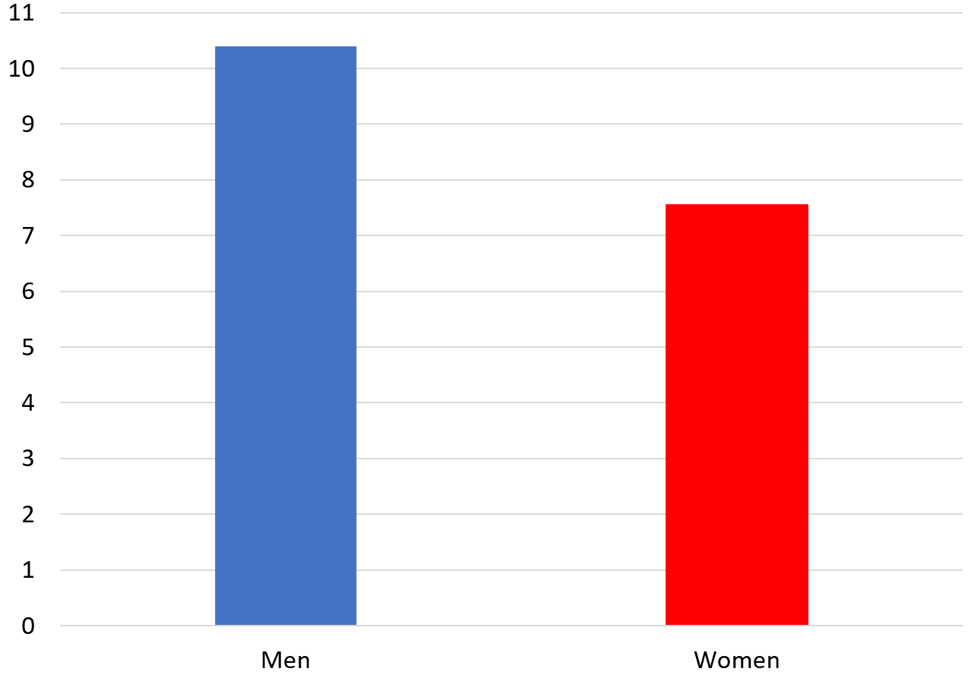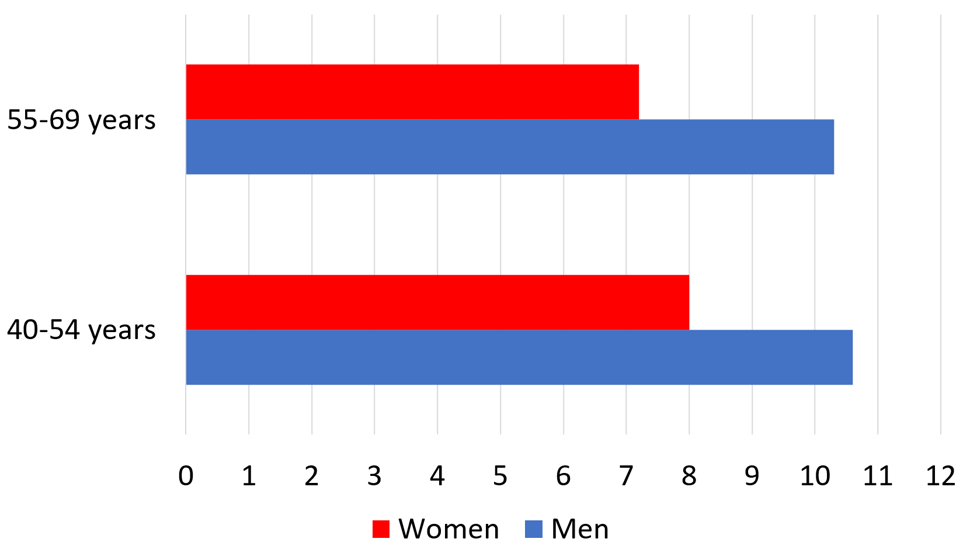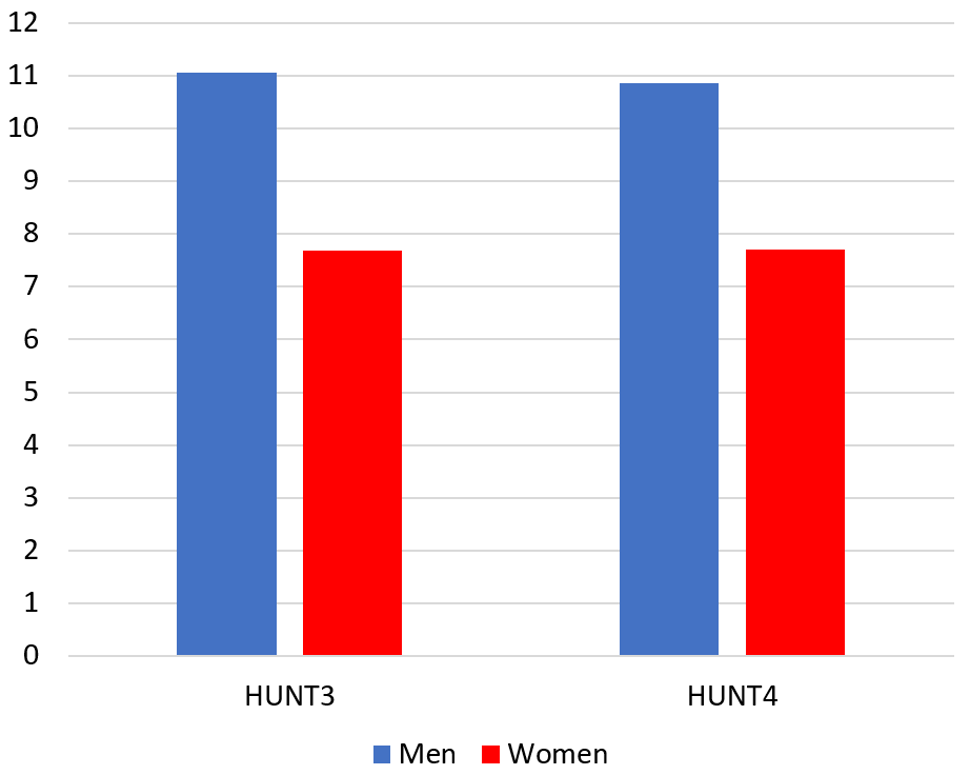Salt intake (Indicator 8)
Last update
The indicator describes the following: Age-standardised mean population intake of salt (sodium chloride) per day in grams in persons aged 18+ years.
This indicator is part of Target (4): A 30 per cent reduction in the population’s intake of salt/sodium.
We lack information on the salt (sodium chloride) intake of the population of Norway. Measuring salt intake in diet surveys is an imprecise method. Measuring the excretion of sodium in daily urine is an internationally accepted and recommended method of gauging salt intake.
Very few such studies have previously been conducted in Norway.
Results
Among participants aged 40-69 years in the seventh wave of the Tromsø Study (Tromsø 7) in 2015-16, the estimated 24-hour salt intake was approximately 10.4 g in men and 7.6 g in women.
Among participants aged 25-64 years in the third wave of the Trøndelag Health Study (HUNT 3) in 2006-08, the estimated daily salt intake was approximately 11 g in men and 7.7 g in women.
The estimated daily salt intake was similar when the study was repeated among participants aged 25-64 years in the subsequent study wave (HUNT 4) in 2017-2019, i.e., approximately 11 g in men and 7.7 g in women, representing no change over the 11-year period.
While the estimated mean intakes are considerably higher than the recommendation in Norway of maximum 6 g/day, they are comparable in magnitude with salt intakes in Finland, Denmark, the UK, and Ireland.



Data sources
The data sources for this indicator are the Tromsø Study and the HUNT Study. A description follows below.
Data source: The Tromsø Study
Description
The Tromsø Study was initiated in 1974 and so far consists of seven repeated health examinations of the population in Tromsø municipality (Tromsø 1-7). Tromsø 7 (2015-2016) included more than 21 000 adults aged 40 years and older, with an attendance rate of 65%. Twenty-four-hour urine was collected from a random sample of 493 participants in the age range 40-69 years. The examination of salt intake measured via sodium excretion in 24-hour urine was conducted by the Norwegian Institute of Public Health as a sub-project of the Tromsø Study.
Effect measure
Estimated mean salt (sodium chloride) intake per person per day in grams, calculated by multiplying 24-hour sodium excretion by 2.54.
Interpretation and sources of error
Measuring salt intake via dietary assessment methods yields imprecise results. Measurement of sodium excretion in 24-hour urine is an internationally recognized and recommended method for gauging the salt intake of a population. Since about 90 percent of ingested sodium is excreted in the urine, the numbers probably provide a slightly low estimate of daily intake. Results are imprecise at the individual level and should be interpreted only in terms of averages of a group.
Reference:
- Meyer HE, Johansson L, Eggen AE, Johansen H, Holvik K. Sodium and potassium intake assessed by spot and 24-hour urine in the population-based Tromsø Study 2015-2016. Nutrients. 2019 Jul 16;11(7).
Data source: HUNT
Description
The Trøndelag Health Study (HUNT) began with HUNT1 in 1984-86 and so far consists of four repeated health surveys in the population of Nord-Trøndelag county. The last two studies are particularly relevant to the period WHO would like member states to report on: 2010-2030. HUNT3 (2006-2008) covered approximately 51 000 individuals aged 20 years and older and had an attendance rate of 54%. Casual spot urine samples were collected from approximately 12 000 participants in HUNT3. HUNT4 (2017-2019) covered more than 56 000 individuals aged 20 years and older, also with an attendance rate of 54%. Casual spot urine samples were collected from approximately 26 900 participants in HUNT4. From each of the two study waves, urine samples from 500 men and women aged 25-64 years have been analysed to estimate salt intake.
Effect measure
Mean 24-hour excretion of salt (sodium chloride) in urine among men and women aged 25-64 years in Nord-Trøndelag, predicted by the INTERSALT equation, based on spot urine concentrations of sodium, potassium, and creatinine as well as sex, age and body mass index calculated from measured body weight and height. Expressed as gram salt (sodium chloride) per 24 hours.
Interpretation and sources of error
Measuring 24-hour urinary sodium excretion is the internationally recognized method for assessing the magnitude of salt intake in a population. As collecting 24-hour urine is resource-demanding, conversion equations for predicting daily sodium excretion from casual spot urine samples have been developed. In Tromsø 7 (see above) where sodium was measured in both 24-hour urine and spot urine samples from the same individuals, the validity of three different equations was examined. The equation developed in the INTERSALT study provided the most precise estimate of 24-hour salt. Therefore, this equation was applied to obtain a rough estimate of daily salt excretion among the HUNT participants. This estimate should only be interpreted in terms of the average on a group level. A limitation of the INTERSALT equation is its tendency to underestimate daily salt excretion at high intake levels, and to overestimate daily salt excretion at low intake levels. However, the spot urine concentrations of sodium were also similar in HUNT3 and HUNT4, supporting the findings of a similar magnitude of salt intake in the two study waves.
References
- Holvik K, Abel MH, Holmen J, Krokstad S, Totland TH, Meyer HE. No change in 24-hour salt intake estimated from spot urine in Norwegian adults from 2006 to 2019. The population-based HUNT Study. medRxiv 2023.08.14.23294065
- Brown IJ, Dyer AR, Chan Q et al. (2013) Estimating 24-hour urinary sodium excretion from casual urinary sodium concentrations in Western populations: the INTERSALT study. Am J Epidemiol 177, 1180-1192.
National adaptation to global indicator
WHO’s definition of the indicator
Indicator 8. Age-standardised mean population intake of salt (sodium chloride) per day in grams in persons aged 18+ years.
National adaptation
The figures from Tromsø 7 apply to a population aged 40-69 years. The figures from HUNT3 and HUNT4 apply to a population aged 25-64 years. The values are not age-standardised.